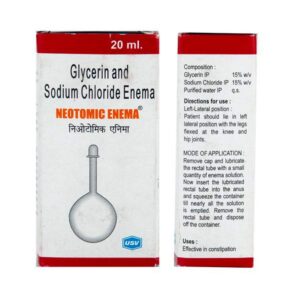GLYCERINE + SOD CHLORIDE
Glycerine: Glycerine, also known as glycerol or glycerin, is a naturally occurring substance that is commonly used in various industries, including cosmetics, food, and pharmaceuticals. In the medical field, glycerine is used as an oral solution or rectal suppository for its laxative and stool softening effects.
Glycerine works as an osmotic laxative by attracting water into the intestines, which softens the stool and increases bowel movements. It also helps to relieve constipation by increasing the water content in the stool, making it easier to pass.
The typical dose of glycerine for oral use is 15 to 30 mL (1 to 2 tablespoons) per day, preferably taken with water or juice. As a rectal suppository, the recommended dose is usually one suppository (2 to 5 grams) inserted into the rectum.
Common side effects of glycerine may include abdominal cramps, bloating, diarrhea, and nausea. These side effects are usually mild and transient. However, excessive use or misuse of glycerine may lead to dehydration or electrolyte imbalance, so it is important to follow the recommended dose and consult a healthcare professional if any abnormal or severe side effects occur.
Glycerine is generally considered safe for use, but it is essential to check the product label for any specific warnings or precautions. It is also worth noting that glycerine should not be used as a long-term solution for constipation, and if symptoms persist or worsen, it is advisable to seek medical advice.
Sod Chloride: Drug: Sod Chloride
Use: Sod Chloride, also known as sodium chloride, is commonly used as a medication to treat or prevent sodium depletion in the body. It is also utilized as a sterile solution for intravenous (IV) infusions and irrigation purposes.
Mechanism of Action: Sodium chloride works by maintaining the appropriate balance of electrolytes in the body. It plays a crucial role in regulating fluid and electrolyte levels, nerve function, and muscle contraction. As a solution for IV infusions, sodium chloride provides the body with the necessary electrolytes to restore proper fluid balance.
Dose: The dosage of sodium chloride can vary depending on the individual’s condition and the route of administration. It is available in different concentrations, such as 0.9% and 0.45%, for IV infusions. The appropriate dose and duration of treatment should be determined by a healthcare professional.
Side Effects: Common side effects of sodium chloride include:
1. Injection site reactions: Pain, redness, or swelling at the injection site.
2. Electrolyte imbalance: Excessive sodium intake can lead to fluid retention and high blood pressure. It can also disrupt the balance of other electrolytes in the body, such as potassium.
3. Edema: Sodium chloride can cause fluid accumulation, leading to swelling in certain areas of the body.
4. Hypernatremia: Abnormally high sodium levels in the blood, resulting in symptoms such as thirst, restlessness, muscle weakness, and confusion.
5. Hypokalemia: Low levels of potassium in the blood, which may lead to weakness, muscle cramps, and irregular heartbeat.
It is important to discuss any potential side effects and concerns with a healthcare professional before starting treatment with sodium chloride.

